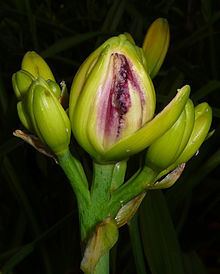Rank Species | Order Diptera | |
 | ||
Similar Daylily, Contarinia, Gall midge, Contarinia medicaginis, Contarinia pisi | ||
Contarinia quinquenotata is a small midge which infests the flower buds of Hemerocallis species causing the flower to remain closed and rot. It is a pest within the horticultural trade in several parts of the world. It is known by the common names of daylily gall midge and hemerocallis gall midge.
Contents
Description
A tiny greyish-grown flying midge about 2mm long that lays its eggs by means of a long penetrating ovipositor in the developing buds of hemerocallis plants during May, June and early July. It is very difficult to see on the wing
Life cycle
There is a single annual cycle. The midge mates shortly after emerging from its winter state as a puparium. The eggs are then laid inside developing buds and hatch into 2mm cylindrical legless white larvae. Their presence and feeding on the plant causes distortion of the plant tissues and failure of the bud to open. The infected bud characteristically becomes more globular that the usual cylindrical shape of a hemerocallis bud, the petals are thickened and a watery liquid is present between the petals in which the larvae live. There can be from a few to hundreds of larvae within a single bud. After further development during the summer the larvae emerge from the aborted flower and drop into the soil where they pupate during the winter and emerge in the following spring.
Distribution
Cotarinia quinquenotata originated in southern and eastern Europe where wild hemerocallis occur. As a horticultural infestation it occurs only in gardens or plant nurseries which contain hemerocallis plants. The midge has been slowly spreading across the world in infested plants aided by the popularity of hemerocallis cultivars as garden plants. It was first noted in the United Kingdom in 1989 and has now spread to many parts of the United Kingdom. It was first reported in Canada in 2001 and has spread into the USA.
The spread is assumed to be within the buds of the imported plants or the soil of the containers.
Commercial impact
Devaluation of infested plants by their failure to produce the attractive flowers favoured by gardeners for their colourful displays. Plants can only safely be shipped without the flower scape and with bare roots. The need to control the midge by whatever means will cause a financial load on the horticultural trade.
Further links
American Hemerocallis Society for further images
